Baseball Card Sets – 1963 Topps
There’s a lot to like about the 1963 Topps set. The colors combine to produce a cheery, uptempo feel, and the patina has worn well. There is a dominant image and a different, smaller one in a circular inset. The player’s name, team and position are easy to read. The backs feature a user-friendly tan and black combination on white-card stock.
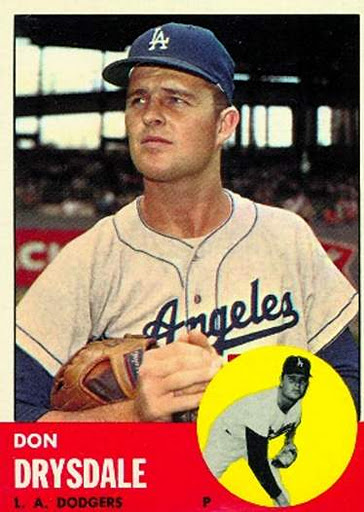 I’ll start with one of my favorite players from that era, right-handed pitcher Don Drysdale. I am drawn to the reflective moment the photographer captured. I wonder what the future Hall of Famer was thinking in that moment. Was he going to start that day? Was the game in the thick of the pennant race? I sense tension in his hands. He was a dogged competitor who had a mean streak, and if he didn’t like you an at bat wasn’t a pleasant experience. He had a side-armed fastball that was pure intimidation. The grandstand shown in the background is an intriguing aspect of the card; where was the photograph taken? Was it the Los Angeles Coliseum, where the team played for their initial four seasons on the west coast, or Dodger Stadium, which opened in 1962? There’s no missing his small image either as it almost jumps off the card due to the yellow background. Drysdale would win the third game of the World Series that fall as his Dodgers waxed the Yankees in four games.
I’ll start with one of my favorite players from that era, right-handed pitcher Don Drysdale. I am drawn to the reflective moment the photographer captured. I wonder what the future Hall of Famer was thinking in that moment. Was he going to start that day? Was the game in the thick of the pennant race? I sense tension in his hands. He was a dogged competitor who had a mean streak, and if he didn’t like you an at bat wasn’t a pleasant experience. He had a side-armed fastball that was pure intimidation. The grandstand shown in the background is an intriguing aspect of the card; where was the photograph taken? Was it the Los Angeles Coliseum, where the team played for their initial four seasons on the west coast, or Dodger Stadium, which opened in 1962? There’s no missing his small image either as it almost jumps off the card due to the yellow background. Drysdale would win the third game of the World Series that fall as his Dodgers waxed the Yankees in four games.
If you were a rookie player featured in this set you didn’t get a body. I guess you had to earn one back then. I’m not certain what’s going on with the card on the lower left. The banner reads 1962 Rookie Stars, the only one in the set to do so. I’ll admit to being confused. Jesse Gonder debuted in September 1960. Sammy Ellis and John Boozer broke in during the 1962 campaign. Ray Culp debuted during the 1963 season.
Several rookie from this set went on to have outstanding careers. The foursome featured on the card on the upper right combined to play 6,473 games, amass 5,794 hits, of which 638 were home runs. Wow!
Rookie cards from ’63 showcased all-time hit leader Pete Rose, outfielder and pinch-hitter extraordinaire Vic Davalillo, Baltimore Orioles pitching mainstay Dave McNally, Pitcher Gary Peters, Catcher Bill Freehan, “Le Grande Orange” Rusty Staub, and two future Hall of Famers, Willie “Pops” Stargell and Pitcher Gaylord Perry.
This set was loaded with terrific players. Here are some of them, in a section I’ll call the Topps 1963 cavalcade of stars.
Extraordinary is the word that comes to mind when I study Curt Flood’s photograph. He’s all business, gazing off into the distance, as if he was already aware that several years down the line he would be taking on what must have felt like the entire baseball establishment, for it was Flood who in 1969 chose to challenge baseball’s reserve clause, which bound a player to one team for perpetuity, rather than accept a trade to another team. He became embroiled in a legal proceeding against Major League Baseball, which he eventually lost. Even though he was never released from his contractual obligation, he paved the way for future big league players to become free agents.
Harmon Killebrew was in the middle of a Hall of Fame career. I like the little slice of the Yankee Stadium frieze on the card’s left. He was a fearsome slugger. He would hit forty-five home runs in 1963, and I guarantee you, sight unseen, most of them traveled a very long way.
Young Ron Santo has his gaze fixed on us. It was very fitting that his two pictures showed the dual aspects of his game, for he was a terrific hitter and a great fielder. He was a perennial all-star who will be inducted into the Hall of Fame, albeit posthumously, this summer.
Juan Marichal, the Dominican Dandy, is shown in Candlestick Park on what I consider a beautiful card. He’s young, poised and handsome, with thirteen productive big-league seasons still in front of him. Most fans forget that he finished his career with the Los Angeles Dodgers. How about that, Giants fans?
Sluggers are always exciting, and here we have two of the best to ever grace a ball field. In his first appearance for the New York Mets, Willie Mays hit the game winning home run. It came against his old team, the San Francisco Giants, as well. I know that made a lot of gray beards in the New York Metropolitan area very happy; they told me so. I was pretty happy about it myself.
Favorite Mickey Mantle cards are a lively topic; this is one of mine. This particular card has a bit of wear. I’ve seen others so sharp the color jumps off the cardboard, including mine, which is rattling around this house somewhere. The portrait shows a composed individual secure in his abilities. The inset Mantle looks like the player I saw swing the bat when I was a boy. On one occasion, my friend Paul and I wanted to go see the Mets, but they were out-of-town, so we went to Yankee Stadium instead. That game was played on Mother’s Day, 1967, so we were present when Mantle hit the 500th home run of his career that day. We clapped until our hands hurt. I recall that Joe Pepitone hit the game winning home run that day, as the Bronx Bombers defeated the Orioles.
These two Hall of Famers are shown on cards with crisp color and nicely centered portraits. Brooks Robinson was the best fielding third baseman I ever saw. Almost every major league player starts off in a minor league and works his way up to the majors. It was often said that Robinson was so good that he came down from a higher league to man the hot corner for the Baltimore Orioles. I like the bird on his cap, too. As for Bob Gibson, it’s hard to believe that he was a sub .500 career pitcher (34 wins – 36 losses) going into the ’63 season, but it’s true. That was about to change in a major way. He certainly was good at this time, but then he got very good. I remember when he made the transition from very good to great. It happened during the 1966 season. After that, he was feared big time.
Manager cards were well done, with crisp pictures and engaging, informative text on the back. Here’s Gene Mauch at the start of what would be a twenty-six year career as a big league manager. His teams got close many times but would never win a World Championship. He was at the helm of the hard luck, 1964 Philadelphia Phillies team that had a six-game lead with twelve games left in the season, only to see their pennant go up in smoke when they went on a disastrous ten-game losing streak. I saw the Phillies play that summer at Shea Stadium with my Dad, and they were very good. Mauch would go to on to have some heart-warming as well as some heart-breaking moments in a career that was a lot like life itself, with ups and downs, problems and solutions, conflicts and resolutions.
The seven-card, World Series subset on the ’62 fall classic is very well done, with action shots from the games shown on the card fronts, combined with brief comments and box scores on the card backs. This world series was a real nail

 bitter, made all the more so when heavy rain storms postponed some games, drawing out the suspense. The Yankees ultimately prevailed, but the Giants came this close to upsetting the Bronx Bombers. This would be the last World Series Championship for the Yankees until 1977, which for them, was a long time between hellos.
bitter, made all the more so when heavy rain storms postponed some games, drawing out the suspense. The Yankees ultimately prevailed, but the Giants came this close to upsetting the Bronx Bombers. This would be the last World Series Championship for the Yankees until 1977, which for them, was a long time between hellos.
No Topps set would be complete without a few clunkers, and this year’s issue does not disappoint. Here are two of them.
Donn Clendenon’s Mother must have been horrified when she saw her son’s card; what kind of expression is that? The grass on the Lew Krausse card looks all wrong; something is clearly going on here.
The first ten cards in the set highlight the 1962 League Leaders from ’62. Like the rookies, these guys have heads but no bodies. I always thought these little heads, which were more or less floating in the air, looked a bit weird. On the other hand, with or without bodies, these players were among the best ever. Get a load of this one, which has five players who are all enshrined in Baseball’s Hall of Fame.
Evaluating this set is easy. The pluses include a nice card design, graphics and photography, with card backs that are easy to read. The minuses include league leaders and rookies without bodies, too many pictures of players without hats (at least 10%) and several clunker cards. Even with these negatives, however, the 1963 Topps set comes up a winner.




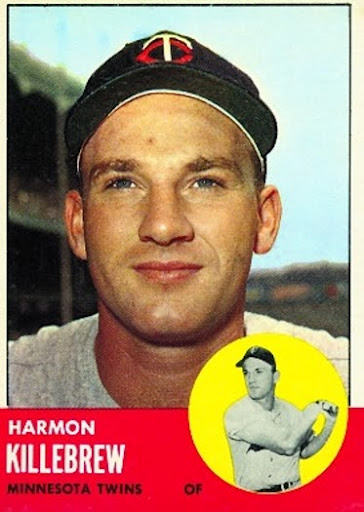


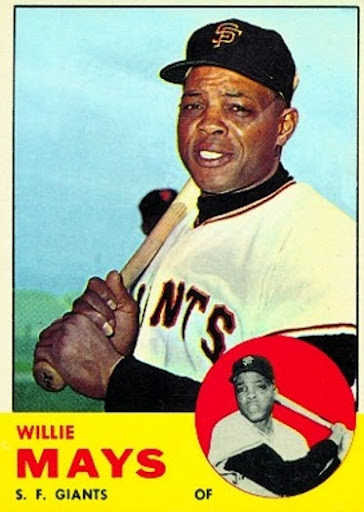
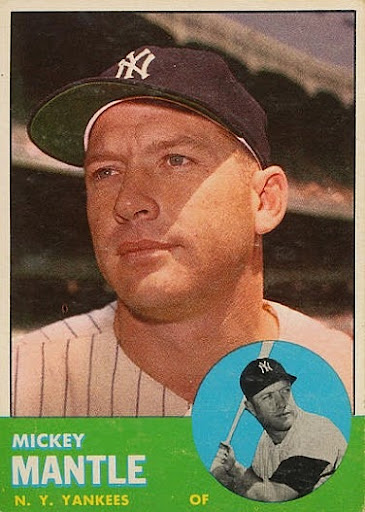


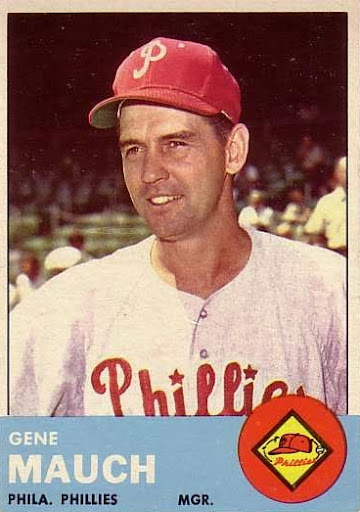





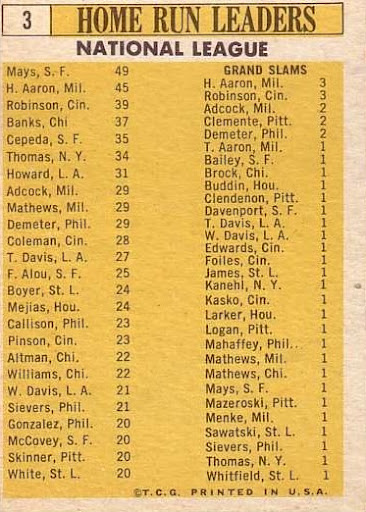
Great write-up, especially with Topps Heritage coming out soon. Thanks for checking out my blog, too!
I’m certainly up for a trade – I marked those cards on my list. Shoot me an email at Chucklesmowry at yahoo dot com with your wantlist or any cards you’d be interested in and I’ll look through what I’ve got.
Thanks!
-Charlie (Lifetimetopps)
Thank you, Charlie. When I heard this year’s heritage format was 1963, I got very excited. Hence this post.
I’ll follow up on a trade, too.
Kindest Regards,
Michael
AKA: Grubby Glove
awesome reflections on the 1963 set, one i barely knew.
you really bring it to life here!
i think marichal was the first and is still the only dominican born player to be in the hof, but that’s about to change in a big way.
i’m still laughing from your description of the floating heads and donn clenendon’s mother
and so insightful what you see in flood’s “all business gaze”
and brooks coming down from a higher league–that’s an inspiring description
and bob gibson’s struggles early in his career? i’m thinking we all might stil have a chance if we locate pitches a little better…
that lew krause photo was maybe a last minute cover up by topps
but sort of reminds me of some allen and ginter or topps turkey red cards
in their dreaminess which mix well with all the reality.
michael…this is an amazing post.
i’m looking forward to more!
and there will be more, Steven. Thank you for your gracious feedback. Enjoy your day, Michael / Grubby Glove